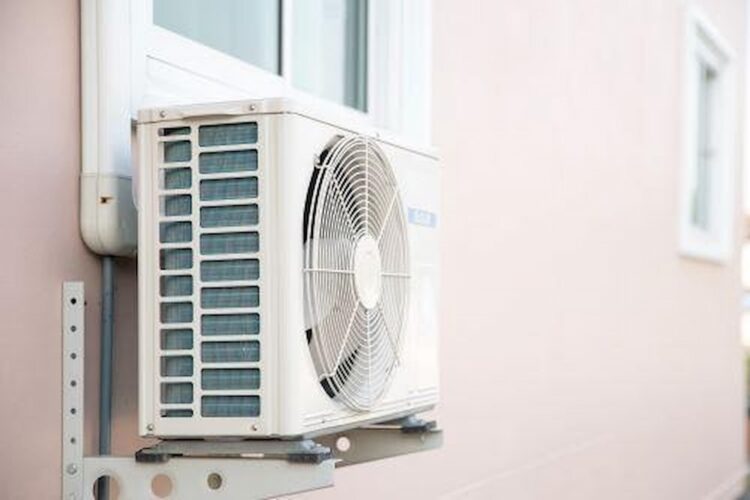Alternative heating methods are definitely in these days, with everyone looking for ways to save money on their energy bills while also trying to minimize their environmental impact. There are a number of new types of heating and cooling that have gained popularity in the last few years, with one of the most popular being a device called a “mini-split heat pump.”
Due to the recent surge in popularity of this advanced method of heating homes and commercial buildings, we thought we’d take some time to explain exactly what a mini-split heat pump is and how it works, as well as the pros and cons of having one installed.
What Is A Mini-Split Heat Pump?
A mini-split heat pump, as its name might suggest, is a miniaturized version of a heat pump. A heat pump is designed to transfer heat from one location to another, bypassing the need for a bulky and expensive furnace. Like many other methods of heating and cooling, mini-split heat pumps make use of two different parts: a compressor/condenser, which is installed outdoors, and an indoor evaporator, which transfers warm (or cool) air throughout a room.
Due to their small size, mini-split heat pumps are generally only used for heating a small area of the house. Unlike a full-size heating system, which is used to heat the entire home regardless of whether it’s necessary to do so, a mini-split heat pump can be used to heat individual rooms. Indeed, if you want to heat the entire house, you’ll need to have multiple heat pumps installed, usually one for each room.
Pro: Mini-Split Heat Pumps Are Perfect For Retrofitting
When you purchase an older property, one of the largest costs involved in the project is retrofitting. For example, if a property doesn’t have a functional system of ductwork, you may have to pay a great deal to have it installed. This can also be a very invasive process, forcing you to have parts of your property moved or irrevocably altered.
Because they don’t make use of a complex system of ductwork, mini-split heat pumps are perfect for retrofitting. The parts are small and non-intrusive, meaning you can essentially install them anywhere you would like to, as long as you have a small amount of space outside for the condenser portion of the pump. You won’t have to shell out a great deal of money clearing out space in your valuable property for a full-sized HVAC system.
Con: Mini-Split Heat Pumps Cost More To Purchase And Install
Since they make use of new and advanced technology, you likely won’t be surprised to learn that mini-split heat pumps are somewhat expensive to purchase and install. Older and more traditional methods of home heating often cost less to purchase, which can save you money initially. You might, however, be more inclined to purchase the heat pump anyway when you think of it as an investment.
Often, the value of a building is increased by a more advanced HVAC system, meaning that your up-front costs might pay off later. It’s worth doing a little research to discover what effect heat pumps have on the property value in your area.
Pro: They May Save You Money In The Long Run
Heat pumps might be on the expensive side to purchase and install, but the cost of running them is generally much less than other methods of heating and cooling. There are several reasons for this: first, a full-sized unit will heat the entire home, essentially wasting energy heating up rooms that no one is currently occupying. Heat pumps, on the other hand, only heat one room at a time, so you can turn on the heat in a room that you’re using and save energy by leaving the heat off in rooms that aren’t in use.
Your heat pump may also save you money as a result of its improved energy efficiency. Because it functions by transferring ambient heat from one area to the next, it doesn’t require costly fuel. You won’t need to purchase gas or coal or utilize a huge amount of electricity to keep your home warm on cold days or cool on warm days. According to the government’s ENERGY STAR webpage, you can save as much as 30 per cent on your energy bill compared to a more conventional air conditioning method.
Con: There Are Possible Aesthetic Concerns
Some people simply don’t like the way a condenser looks when it’s installed outside the home. This is an aesthetic concern that ultimately comes down to personal preference. After all, some people don’t like the appearance of outdoor air conditioning units either, but they find ways to make them work. Discuss your aesthetic concerns with your contractor and ask if there are ways to conceal the condensers so as to avoid creating an eyesore.
Pro: No More Fighting About The Thermostat
Besides the financial benefits, a heat pump’s ability to heat individual rooms differently has another major upside: you will no longer need to fight with family members or coworkers about the temperature. You may prefer it to be a little on the warmer side while family members in other rooms prefer it to be a little cooler. With heat pumps installed, you can set the thermostat in your room a few degrees higher without making everyone else miserable.
Con: Many Contractors Are Not Familiar With Heat Pumps
Heat pumps are a great method for heating and cooling the home, but they’re also a fairly new and advanced piece of technology. This means that many contractors may not be familiar enough with them to effectively perform installation and maintenance.
You should take great care when you’re searching for a contractor who can work with heat pumps because many of them will claim to be able to and will accept jobs, but they may not perform the installation effectively. Even slight miscalculations during the installation process might end up increasing your monthly bill significantly, so look for a company like Entek. Our certified technicians have a great deal of experience with mini-split heat pumps.




